Back to page 1
The Design
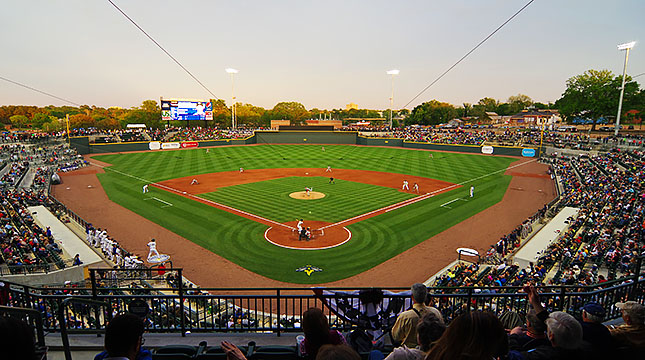
The architectural design of the interior is impressive. While by no means do you ever feel cramped, every square foot is intelligently utilized. Much of this is to provide the incredible number of different seating options, including Concourse Suites right on the concourse at the rear of the seating bowl.
The concourse itself is open to the field, giving fans a view of the action on their way to and from concession stands. And a personal favorite feature, a 360-degree concourse (a la Nashville’s First Tennessee Park), is ready for fans to circle the playing field.
The upper level is positioned to provide maximum shade for the seating bowl below – which will be quite welcomed in the South Carolina summer.
 |
And that upper deck is beautiful, although it reminds me more of Nashville (also a Populous project) than Fort Wayne. It contains 16 Luxury Suites sandwiching the massive 7,000-square-foot club (above) – and its three rows of club seats – and a fairly small pressbox. At the third-base end of the upper level is the Broad River Balcony (below left), which can accommodate a group with as many as 120 attendees. Sabatini explained that they designed the foundation of the park so that another group area could be built onto the first-base end of the upper level one day. Count on it, because Freier told me that the Broad River Balcony almost sold out for the entire season as soon as group tickets went on sale.
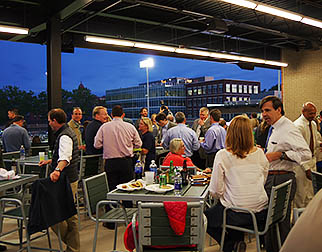  |
There’s an oddity that I didn’t like in the upper level, though. In front of the first row of club seats, there is a raised area a couple of inches high where the floor and the front of the section come together (above right). I suspect it’s there for structural integrity somehow, but I fear that it could cause someone to stumble, especially when walking in front of fans who are sitting in the front row. I know I did, because you certainly don’t expect a raised area to be there. And if you stumble, well, bad things could happen since you’re at the very front of the upper deck.
A major difference between Nashville’s new stadium and Spirit Communications Park involves field suites. First Tennessee Park has four of them adjacent to the third-base dugout. Their floor is actually below the level of the field. Between the enclosed area and the seats next to the warning track of the field, each suite can accommodate 55 well-heeled fans.
Not so in Columbia. “We decided we didn’t want anything like that here,” said Freier. “Suites like that move the rest of the field boxes farther back from the field, and we wanted our fans as close to the action as possible. They also create a distinct division between fans, and that’s not what we are trying to achieve.”
Instead, you have the myriad types of seats seamlessly next to each other. Directly behind the backstop are padded On Deck seats, with standard plastic seats behind them. At the rear of the sections behind home plate are Scout Seats, complete with drink rails (below left). Directly behind the seats in the odd-numbered sections are the Concourse Suites, with partitions to separate them from the rest of the concourse (below right).
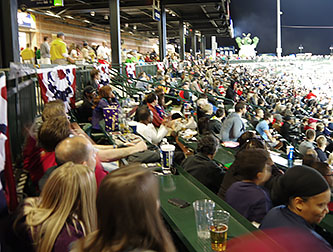 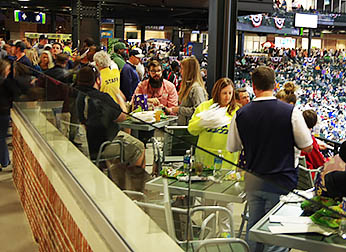 |
Both the right-field and left-field corners contain dozens of tables with four chairs. Near the concourse down the lines are 24 of the ever-popular Four Topps, where the table is a semi-circle, with four chairs. “The tables themselves cost us a lot to buy,” Freier noted, “but fans really love them.”
The outfield also features a variety of seating types, including rocking chairs (below left) – which are on a first-come-first-served basis – and generously sized berms. The right-field berm is terraced (below right), making it even nicer to sit on.
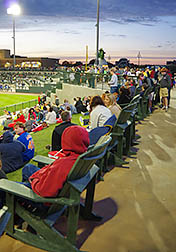 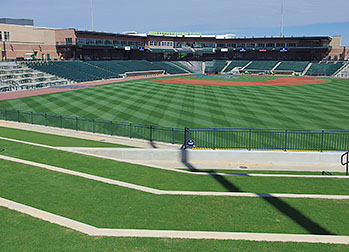 |
When I asked team president John Katz to name his favorite feature of the new park, he replied, “I don’t like to sit at baseball games. I’m a wanderer, as I walk around the park. So I really like the two unique perches we have that are cantilevered out over center field on either side of the batters eye. The centerfielder can be going back on a fly ball and have a lot of room to spare (before reaching the wall), and it can still be a home run by landing on the perch.”
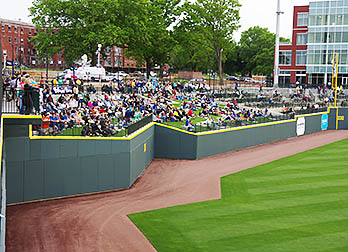 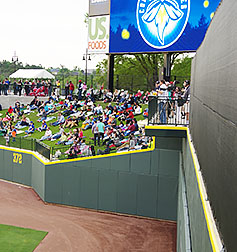 |
| Here are the two “perches,” each looking at the other perch. You can also see that the outfield dimensions are quite irregular, making for some hard-to-predict bounces off of the walls. Fans like that. |
The Essentials
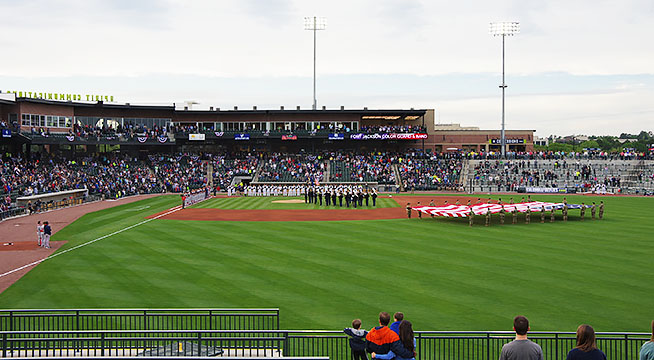
While you probably won’t be blown away by the variety or high-end quality of the concessions, you will be stunned by the affordability of attending a Fireflies game.
If you park in one of the lots that aren’t free, it will only cost you $3. If you are in a lot a couple of blocks away, a free shuttle will transport you to the front gate of the park.
The cost of tickets, honestly, is astonishing to me. Following the long absence of pro ball in Columbia, and the impressive nature of the facilities of the park, I expected seats close to the field to cost in the $18-20 range, and those slightly farther from home to be $14-16.
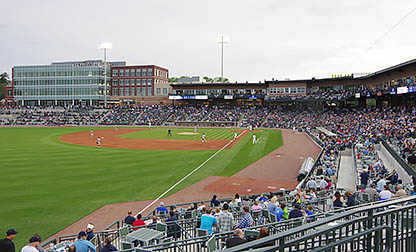 |
I was certainly in for a shock, especially when you compare the Fireflies’ prices to the newly opened Southern parks in Nashville and Biloxi. In Columbia, the padded On Deck seats directly behind the backstop cost $12 – when you can get them, since they are largely season tickets. Most of the rest of the main seating bowl is referred to as All Star seats, and they are $10. In Nashville, their Premier seats in the infield are $24, while the last few rows (which they call Select seats) are $17. In Biloxi, the rows closest to the field are $27 and the rows behind them are $15.
Columbia doesn’t charge extra for “premium” games, nor do they tack on any money for tickets purchased on the day of the game. Both Nashville and Biloxi do, adding $2 to the prices above. And while the Sounds and Shuckers charge $7 and $10 respectively for general admission tickets, Fireflies fans pay only $5.
These differences are astonishing. I asked Freier if he was leaving money on the table by charging less than he could easily get away with. “We look at this as a volume business,” he explained. “We want our fans to come to the park, have fun and feel like they received a good value. Then they’ll want to come back – and bring their friends.”
A similar dynamic is at work with concessions. While newer parks like in El Paso, Charlotte and Biloxi have gone head over heels with incredible dishes prepared at stands run by local restaurants, the Fireflies have made a conscious effort to buck that trend.
“We’ve never been ones to look at what others are doing and then try to do the same,” Freier revealed. “We’ll use local people who know what they’re doing, but we’d rather run our own stands. That way we can control what’s served and make sure we’re charging our fans a fair price.” Again, the Fireflies want repeat customers, not fans who are wowed by incredible culinary creations, but then grumble about how high the concession prices are. To accomplish this, the team keeps it all in-house.
“We’re not Ruth’s Chris Steak House,” Scott Burton, the Senior VP of Food & Beverage, told me with a laugh. “We can make something that is pretty good and that people can afford. We probably had 100 (local) people call us and say they wanted to make our snow cones, but by the time they add in their mark-ups, they want to charge more than we think is affordable. So we do them ourselves and sell them at our price.”
He added, “We want people to have a good time and feel they didn’t pay too much.”
The Fireflies’ approach is to sell ballpark staples at four permanent concession stands at the rear of the concourse behind the main seating bowl, Burton explained. “What moves for us is normal ballpark food like nachos, hot dogs, chicken tenders, fries (and) hamburgers. We added in some other items we thought would be popular like corn dogs, plus since we have pizza ovens behind two of the stands, we can serve freshly baked pizza, too.”
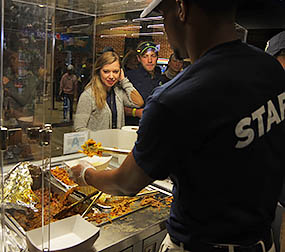 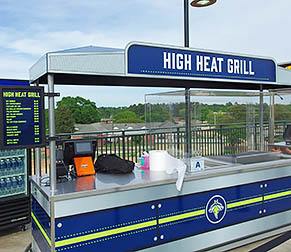 |
To supplement the four main stands – which can get pretty crowded with fans waiting in line – free-standing carts sell more specialized items. For instance, the team is very proud of its Low And Slow BBQ Cart, which is behind home plate. Here you’ll find a BBQ pork sandwich for $7, a very tasty brisket sandwich for $9 and “Three Little Pigs,” which is a trio of sliders, each with a different sauce for $7. The three sauces are a standard tomato-based sauce, a delicious commercially available sauce called Carolina Gold and “a vinegar-and-pepper sauce we make ourselves, which I think is really, really good,” says Burton.
Other specialty carts include the cleverly titled Funnel Vision with funnel cakes made right in front of you ($5), the Palmito Mexican Grill featuring four types of huge burritos ($8), Sweet Carolina’s cotton candy and snow cones ($3.50 each) and the Slider Shack with mini hot dogs (two for $5) and burgers (two for $6).
Burton told me that he thinks the Tri-Tip Sandwich, available at the High Heat Grill cart in left field for $8, is the best-tasting item they sell. “To me, the second best thing we offer are all of the sausages. We have Italian, Hot Italian, Brats and Polish, and they’re all great.” They are all $6 and are also at the High Heat Grill.
Hint: if the lines are too long on the main concourse, stroll out to the outfield where the lines for the carts are much shorter.
As you’d expect, the food and drink is a little more sophisticated on the upper level, where the suites and club seats are located. Burton said that fans there will enjoy a local product called Caramel Moonshine Ice Cream, and a variety of high-end wines are available, too.
Keeping with the team’s fervent desire to have affordable concessions, the beer prices are also lower than they could get away with charging. Domestic beers are $7 for 24 ounces and $5 for pints. The prices are half of those figures on Thirsty Thursdays, which included Opening Night. Their craft beers are only sold in pints, and cost $7. “This is a college town,” Burton noted, “so there are a lot of bars here. We have to compete with happy hours all over town, so we keep the prices of our beers very reasonable.”
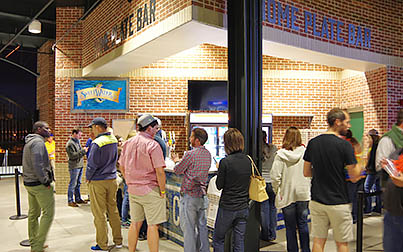 |
Notably, a brewery out of Atlanta called SweetWater operates a beer stand directly behind home plate (above). Their own brand of beer is a staple in Georgia and the Carolinas, and the lines were always long to buy their drafts.
The lines were also long inside the Mason Jar, the team’s spacious merchandise store. The popularity of the team’s firefly logo is unmistakable, but to me it doesn’t really say “baseball” at all (couldn’t part of the insect’s wings been shaped a little like a baseball bat?). It is undoubtedly cute and modern, though.
The cost of souvenirs and apparel isn’t astonishingly low, but the prices are reasonable. Adult t-shirts ranged from $18 to $25, and while kids T’s were $16 to $20. Adjustable caps for adults ranged from $18 to $28, while all fitted caps were $25. Kids’ caps were $15.
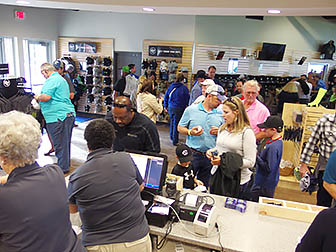  |
College basketball teams at Baylor and Oregon have popularized the neon “highlighter yellow” color that I find to be an assault on my eyes. The Fireflies are taking advantage of this with a neon-yellow t-shirt for $23 and an adult polo for $64 (above right).
The whole concept of capturing fireflies in a mason jar is not only reflected in the name of the souvenir store, it’s also the name of the team’s mascot (below left). Mason follows the trend of big, fuzzy mascots who are a slightly indistinct type of animal – but whom kids love.
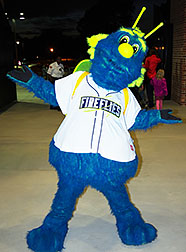  |
The glow of fireflies is also reflected is some very clever signage. To the left and right of the name of the store is a ribbon board of sorts made up of hundreds of neon-yellow LEDs that glow (above right). The effect is particularly noticeable after it gets dark. A very clever touch.
There is a kids’ play area down the left-field line with more inflatables that you’ll usually find at a ballpark. I wish there was netting to protect the area from foul line drives, but one hopes those won’t be too frequent. Interestingly, the gorgeous ballpark that Populous designed for the University of South Carolina baseball program across town has a very popular play area for kids, and it is very well-protected by netting.
The enjoyment of the fans is certainly enhanced by a super-sharp video screen in left field and an excellent sound system. Well done.
All in all, the Fireflies have come right out of the gate with a well-polished gameday experience. Certainly the success this ownership team has enjoyed in Savannah and Fort Wayne made this do-able. No doubt, the fans’ enjoyment is certainly increased when they stop to consider how affordable a game is at this first-class facility. They know how to put on a good fireworks show, too.
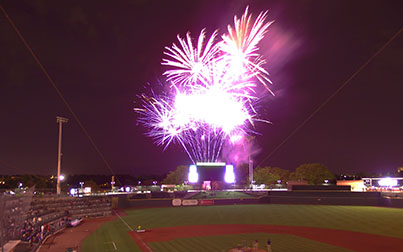 |
Summary
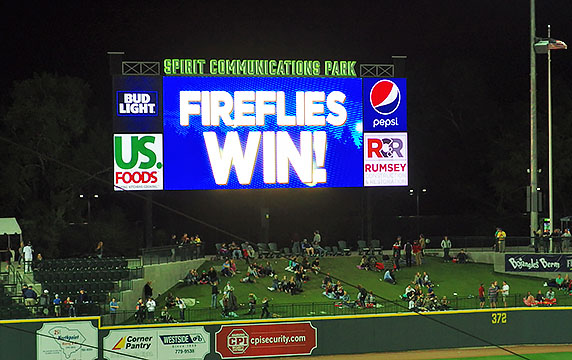
There are a number of ironies and coincidences involving the Fireflies. The previous affiliated Minor League team was affiliated with the Mets, and now the Fireflies are their Low-A farm team. When the Capital City Bombers (as they were called before they moved) left town, they went to Greenville, SC – and helping to make the lower downtown area of Greenville (where beautiful Fluor Field was built) an incredible showplace of shops and restaurants was Hughes Development, the same company that donated the land for Spirit Communications Park, and who is the master developer for the entire 181-acre campus that surrounds it.
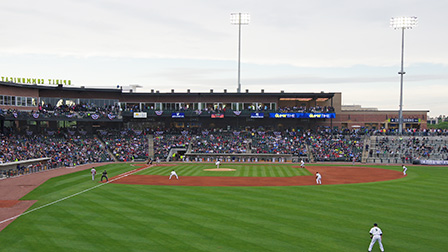 |
And as mentioned earlier, it was the Greenville Drive who provided the opposition when Columbia’s new park made its debut. It all came together in the ballpark’s first pitch, shown above. And the visitors accommodated their hosts by losing. Serves Greenville right for stealing Columbia’s team in the first place!
But attending a Capital City Bombers game at Columbia’s dilapidated Capital City Stadium was never anything like this. And the way Columbia achieved the accomplishment of opening the new park is amazing – from a financial perspective, from a quality-of-facility perspective and from a timing perspective.
In an age when Minor League ballparks fail to come in under budget (Nashville’s park was $10 million over budget) and on time (the new parks in Biloxi and Hartford missed their targeted completion dates by about two months), Columbia’s Spirit Communications Park is a marvel.
I asked Tucker, the City’s project manager, how Columbia was able to accomplish what other cities couldn’t. “We had the right people on the bus,” he replied. “We had the right design team in Populous, who had an outstanding résumé of ballparks. We had the right contractor, which was made up of companies like Barton Malow who’d done sports complexes before. We had the right ownership group for the (baseball) team in Hardball Capital, and they knew what they wanted. The members of the team on this project gelled well right from the beginning.”
And to Mayor Benjamin, the park couldn’t have turned out better. “It’s beautiful. It’s truly a world-class Minor League facility. You can find something for all people there, from the berms for overactive children to places for professionals to gather to spots where true baseball aficionados will be happy.
“If we were going to do it, we had to do it right,” he concluded.
And by bringing Columbia’s past to meet its future, they did exactly that.
Feel free to add your thoughts about Spirit Communications Park or this review below.
Beautiful Park….poor customer service once in the park. I loved the trolley shuttle and was looking forward to a great family-friendly first-time experience at the park. Unfortunately, that wasn’t what we received once in the park. It was our first time seeing the Fireflies. Our seats were near the railing. My son stood up and went over to railing to hopefully catch a ball. One of park’s staff named Laura walked up to my 7 year old and told him that he better stay seated or she personally would see to it that he got put out of the park if he didn’t obey. I WAS FLOORED! He wasn’t being disruptive, yelling or hanging over the railing like other children we saw nearby; he waiting hoping that one of the fly balls would come his way. He hadn’t been near the rail a good 5 minutes before she came over. I could see if there were previous warnings–there weren’t! We just got there!!! There were no rules posted and since we both were new to the park, we didn’t know there was a protocol about standing near the railing. I was upset and my son was very upset. He was in tears and kept repeating to me that he didn’t know and that he was just waiting for the ball. What I couldn’t understand was why she spoke to my son and not to me–his parent–since I was right there in very close proximity. We left the park early before the game ended. I saw her as we were leaving and let her know that I understood safety concerns, but the threats were totally uncalled for. Totally ruined our evening.
Very sorry to hear about your bad experience. I am quite sure the front office of the Fireflies would like to know about it. I’ve found them to be very caring and responsive.
Your article has me extremely excited to be attending opening day this year, I wanted to attend their inaugural season but wasn’t able to unfortunately. I was looking for some general feedback about the stadium and its atmosphere, and you definitely delivered. This makes me feel like a kid attending his first baseball game all over again, and I’ve attended several Greenville Drive games. I don’t remember ever being this excited for a Greenville Drive game.
I’m glad you liked our review. And while Greenville’s ballpark is really nice (it was our Ballpark of the Year the year it opened), it’s no match for Columbia’s new showplace. There’s so much to see and do there. Enjoy it!